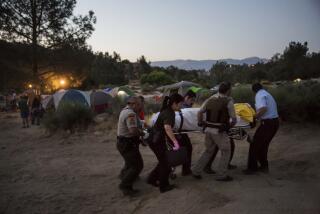County Begins Effort to Warn of Pool Perils
- Share via
Mom was doing chores inside the house, while Dad stepped out front to pick up the mail. There was no one to see 23-month-old Trevor as he slipped beneath the surface.
Rich Heider returned moments later to find his son floating in the family’s backyard pool. The Mission Viejo man screamed for his wife to call 911 while he pulled the boy out, and a neighbor who heard the parents’ cries performed CPR on the youngster--and saved his life.
The Heiders continue to give daily thanks for the rescue of their son, who did not suffer permanent injuries, by trying to prevent other parents from making the same mistake they did.
“My message is ‘Please don’t let this happen to you.’ It’s 100% preventable,” said Jill Heider, a spokeswoman for the annual Child Drowning Prevention Campaign being announced today by the Orange County Fire Authority and Children’s Hospital of Orange County.
Orange County led the nation in child drownings in 1993, when 20 children under age 6 died. That number has dropped considerably--last year, seven children under 6 drowned in Orange County--but drownings remain the leading cause of death for toddlers in California, according to the state’s Department of Health Services.
And that means constant vigilance is necessary, said Capt. Scott Brown, spokesman for the Orange County Fire Authority.
“Our goal is to have zero drownings,” Brown said.
Southern California remains one of the most drowning-prone areas nationwide, in no small part because of the climate.
“Drowning is a year-round problem here,” said Brown, who said Orange County children have greater access to the water, too. In addition to the Pacific Ocean, there are 108,000 residential pools, where most drownings occur, he said.
In the past, the county’s annual campaigns focused on basic prevention. Pool covers. Safety fences. Warning parents that it’s never safe to leave children unattended near the water. And urging parents to learn cardiopulmonary resuscitation and other rescue techniques.
This year, the campaign will target pool owners. Brown said a database of all Orange County pool owners will allow the campaign to focus its efforts. They expect to distribute more than 20,000 drowning prevention brochures and “water watcher” tags to be worn by the adult in charge of supervising children near water. Drowning prevention and free CPR classes will be available throughout the county.
It’s also critical to call 911 immediately when a drowning or near-drowning has occurred, even if someone present knows CPR, Brown said.
Earlier this year, a 16-month-old girl drowned in a Huntington Beach pool while playing with her brother. The child’s frantic caretaker tried to call the girl’s parents before dialing 911, causing a delay, said Martha Worth, a spokeswoman for the city’s Fire Department.
“Calling 911 is really important, even if you know CPR,” Worth said.
Another worrisome trend has emerged from a recent analysis of drowning statistics, officials said. Many drowning victims come from non-English-speaking families. CHOC and the Orange County Drowning Prevention Network are working to raise money to produce a Spanish-language video on drowning prevention. The county’s campaign currently provides information to residents in Orange County’s Latino and Asian communities, but all agree more needs to be done.
The Drowning Prevention Network was founded by Newport Beach father John Landis after his son, Jeffrey, nearly drowned in 1989. The 18-month-old fell into the pool while his father walked out to the garage. The boy was rescued and did not suffer any permanent injuries.
Not everyone is so fortunate. Many children rescued from drowning suffer permanent brain damage, Brown said. And an accident, even one with a happy ending, still takes its toll.
Jill Heider, for example, said her family has struggled in the aftermath of Trevor’s accident. Jill Heider said her children were traumatized by the incident, and she and her husband often felt as if friends questioned their parenting skills, creating pressure in their marriage, she said.
“Drowning doesn’t happen [only] to bad parents,” said Mary Marlin, who manages the Community Education Department at Children’s Hospital. “It happens to everybody; the water doesn’t care.”
(BEGIN TEXT OF INFOBOX / INFOGRAPHIC)
Drownings in O.C.
The number of young children who drown has sharply decreased from 20 in 1003 to seven last year, according to the coroner’s office.
Prevention at the Pool
* Install several types of barriers, including a four sided fence with self-closing gate, pool alarm and locked pool cover to give maximum protection, even if no children are living in the house.
* Keep rescue equipment on hand, including life preserver ring with 50-foot lightweight line attached and shepherd’s crook.
* Ask an adult swimmer who knows CPR to supervise children under 12. the American Red Cross and local hospitals offer CPR classes.
* Have a cordless phone at poolside in case of emergency.
* Keep toys away from the pool, especially those a child rides.
* If child is missing, look in the pool or spa first. It takes only two minutes underwater for a child to lose consciousness. Irreversible brain damage occurs after four to six minutes.
* Screams of a drowning child may not be heard. Children are top-heavy and tend to go in headfirst, without resurfacing.
* Recreation experts recommend swimming lessons for children beginning at age 3. However, the American Academy of Pediatrics warns that lessons for children under 4 may lead to a false sense of security.
* A few words of caution to adults: Alcohol, drugs and swimming don’t mix. Never swim alone. And limit your time in hot tubs.
Sources: Orange County Sheriff-Coroner; Researched by IONA PATRIN / Los Angeles Times
More to Read
Sign up for Essential California
The most important California stories and recommendations in your inbox every morning.
You may occasionally receive promotional content from the Los Angeles Times.













